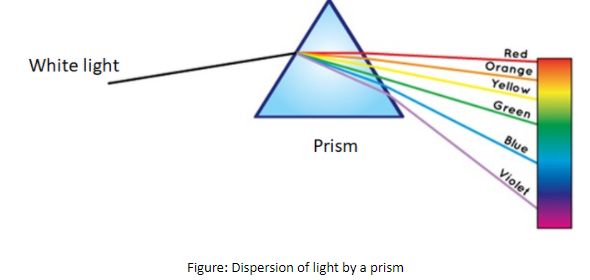
Explain dispersion by a prism with the help of a diagram.
Answer
537.6k+ views
Hint: It involves the splitting of white light into seven constituent colors when passed through the prism.
Complete step-by-step answer:
When visible white light passes from one medium to another medium through a glass prism it causes the light of different colors to be refracted differently and to leave the prism at different angles. It is creating a rainbow type effect; the phenomenon is known as the dispersion of light. In this phenomenon, the phase velocity of a wave depends on its frequency. The visible light consists of 7 colors which are violet, indigo, blue, green, yellow, orange, and red, starting from bottom to top. The violet light is more deviated than any color and red is less deviated. Prisms used to reflect light or to split light into its components with different polarizations.
The degree of bending of the light's path based on-
-The angle which incident beam of light forms with the surface
-And the ratio between the refractive indices of the two media
The refractive index of materials such as glass changes with the wavelength or color of the used light. Prisms are occasionally used for the internal reflection at the surfaces instead of dispersion.

Note: -The optical density is described as simply a measure of the tendency of a material to slow down light when it travels through it.
-After the dispersion of light, the separation becomes even greater and ROYGBIV is observed.
-The angle of deviation is explained as the overall amount of refraction caused by the passage of a light ray through a prism.
Complete step-by-step answer:
When visible white light passes from one medium to another medium through a glass prism it causes the light of different colors to be refracted differently and to leave the prism at different angles. It is creating a rainbow type effect; the phenomenon is known as the dispersion of light. In this phenomenon, the phase velocity of a wave depends on its frequency. The visible light consists of 7 colors which are violet, indigo, blue, green, yellow, orange, and red, starting from bottom to top. The violet light is more deviated than any color and red is less deviated. Prisms used to reflect light or to split light into its components with different polarizations.
The degree of bending of the light's path based on-
-The angle which incident beam of light forms with the surface
-And the ratio between the refractive indices of the two media
The refractive index of materials such as glass changes with the wavelength or color of the used light. Prisms are occasionally used for the internal reflection at the surfaces instead of dispersion.

Note: -The optical density is described as simply a measure of the tendency of a material to slow down light when it travels through it.
-After the dispersion of light, the separation becomes even greater and ROYGBIV is observed.
-The angle of deviation is explained as the overall amount of refraction caused by the passage of a light ray through a prism.
Recently Updated Pages
Vedantu JEE/NEET Scholarships 2025: Apply Now

Reading Comprehension Stories with Questions & Answers – Free PDF

Order of Operations Worksheets for Class 3 with Answers

Class 5 Maths 4 Operations Word Problems Worksheet PDF

Class 1 Reading Comprehension Read and Color Worksheets PDF

Biology Explained: Branches, Topics & Essentials

Trending doubts
1 ton equals to A 100 kg B 1000 kg C 10 kg D 10000 class 11 physics CBSE

Difference Between Prokaryotic Cells and Eukaryotic Cells

One Metric ton is equal to kg A 10000 B 1000 C 100 class 11 physics CBSE

1 Quintal is equal to a 110 kg b 10 kg c 100kg d 1000 class 11 physics CBSE

Proton was discovered by A Thomson B Rutherford C Chadwick class 11 chemistry CBSE

Draw a diagram of nephron and explain its structur class 11 biology CBSE




